3D Websites: When They Work and When to Avoid Them
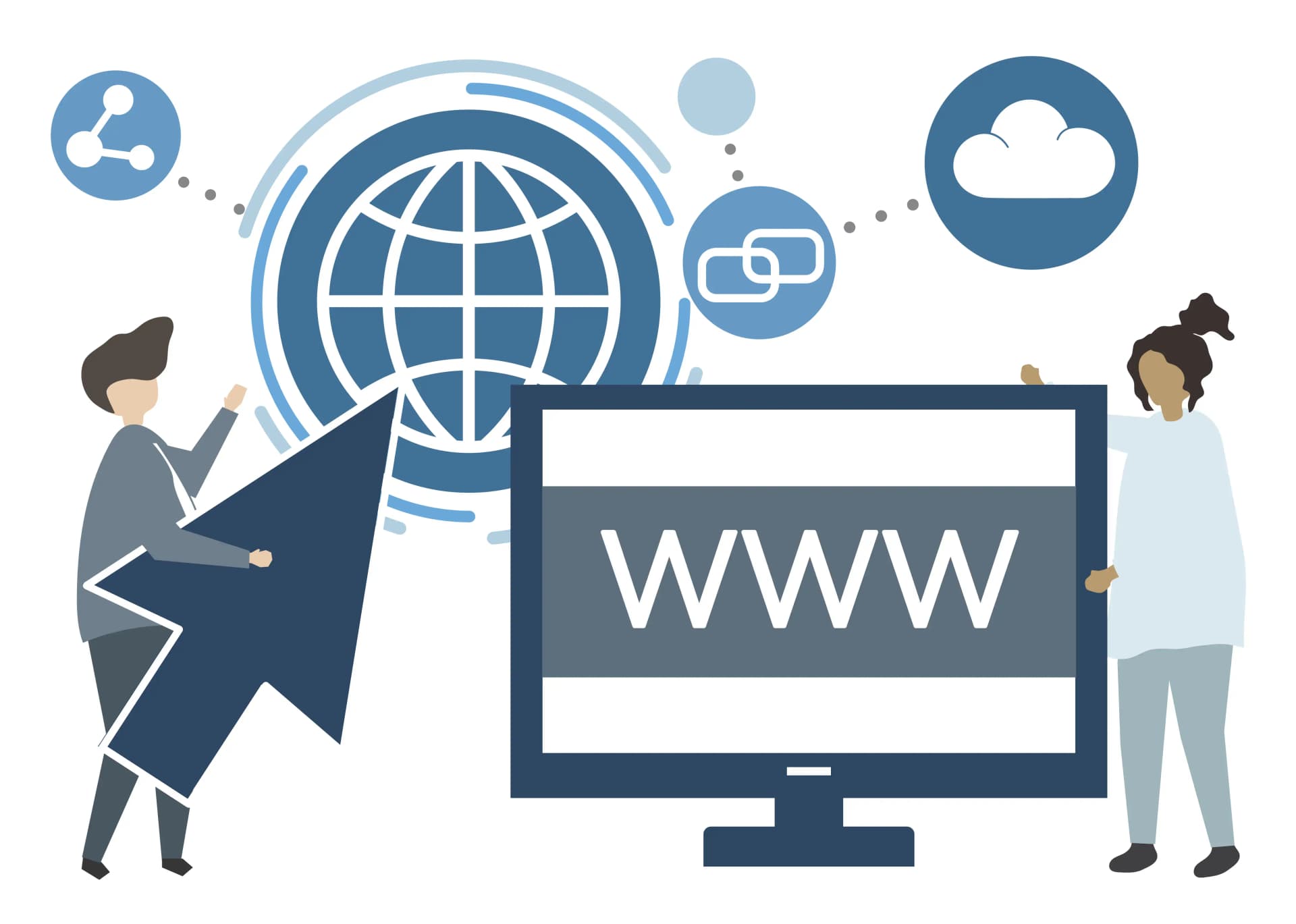
Introduction
3D websites are undeniably captivating and can immediately grab attention.
However, before using them, it’s essential to ask yourself: are they truly worth it for your business? In many cases, a poorly designed 3D website can become a costly failure, resulting in lost customers and diminished online credibility.
In this article, we’ll explore where most companies go wrong and how to determine when 3D design can genuinely enhance your website’s effectiveness—avoiding common mistakes while maximizing results.
Main Challenges of a 3D Website
There are several obstacles to consider when planning a 3D website.
This section analyzes the main issues, highlighting risks and challenges often overlooked.
User Experience and User Interface (UX/UI)
A 3D website can be visually impressive, but navigation often becomes complex, impacting the overall user experience.
Common issues:
- Confusing navigation and unclear interactive elements
- Distraction from primary content
- Longer learning curve for less experienced users
- Limited accessibility for people with visual or motor impairments
Impact:
Poor UX/UI can increase bounce rates and reduce conversions.
Tip:
Always balance visual effects with ease of use and test the site with real users.
Performance and Loading Speed
3D elements require high resources, which can significantly slow down your site.
Common issues:
- Long loading times, especially on mobile devices
- Incompatibility with older browsers
- High bandwidth and device resource consumption
Impact:
A slow website can drive users away, negatively affect SEO rankings, and harm brand reputation.
Tip:
Optimize 3D models and animations, use lazy loading, and perform regular speed tests.
Cost and Development Time
Creating a 3D website requires specialized skills and advanced tools.
Common issues:
- Higher budget than traditional websites
- Longer development time
- More complex and costly maintenance
Impact:
Risk of an unsustainable investment if ROI is not carefully evaluated.
Limited SEO
3D content can be difficult for search engines to "read."
- Text inside 3D elements or canvases may not be indexable
- Reduced organic visibility if SEO-friendly alternatives are not implemented
Tip:
Always include descriptive text, meta tags, and schema markup.
Accessibility
3D websites can create barriers for users with special needs.
Common issues:
- Challenges for users with visual, auditory, or motor disabilities
- Need to follow more complex WCAG standards
Tip:
Test accessibility throughout the design and development process.
Compatibility and Responsiveness
Not all devices or browsers handle 3D content perfectly.
Common issues:
- Inconsistent experience across desktop, tablet, and mobile
- Potential bugs or crashes on lower-performing devices
Tip:
Perform cross-browser and responsive testing.
Updates and Scalability
3D websites require ongoing attention even after launch.
Common issues:
- Updating content or adding features can be complex
- Increased risk of bugs as site complexity grows
Tip:
Plan regular updates and consider scalability from the beginning.
Test Cases
I analyzed several 3D websites to provide concrete examples and help illustrate the concepts discussed above.
The data comes from public tools like Lighthouse and is used solely for educational purposes.
Example 1: Samsy Ninja
This 3D website is a true digital artwork.
From the moment users enter, they immediately perceive the creativity and expressive power of a modern interactive portfolio.
Scenario:
The developer/artist’s priority is not performance, accessibility, best practices, or SEO.
The site’s goal is to showcase creative skills and design capabilities.
Lighthouse scores:
- Performance: 48/100
- Accessibility: 64/100
- Best Practices: 59/100
- SEO: 92/100
Takeaway:
These types of websites are not ideal for projects that require maximum performance or accessibility (e.g., e-commerce, business sites, blogs, web apps).
For creative professionals, however, they serve as an excellent personal showcase.
Web Site :
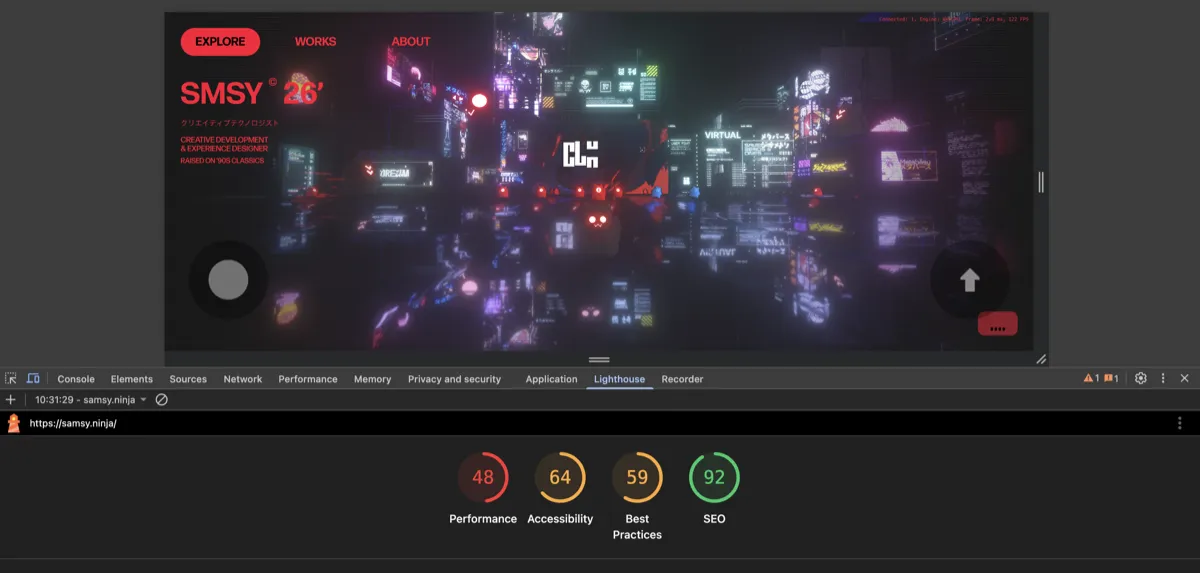
Example 2: We Enable
This 3D website is designed for a business.
The 3D elements are minimal and elegant, ensuring the site remains smooth, readable, and practical.
Scenario:
The developer prioritizes accessibility and SEO.
The goal is to create a modern business showcase with light 3D animations that enhance professionalism without compromising the user experience.
Lighthouse scores:
- Performance: 69/100
- Accessibility: 94/100
- Best Practices: 78/100
- SEO: 92/100
Takeaway:
Sites like this are ideal for projects requiring modern design, solid performance, and high accessibility, such as business showcase sites.
They are not the best fit for artists or designers seeking a creative web canvas.
Web Site :
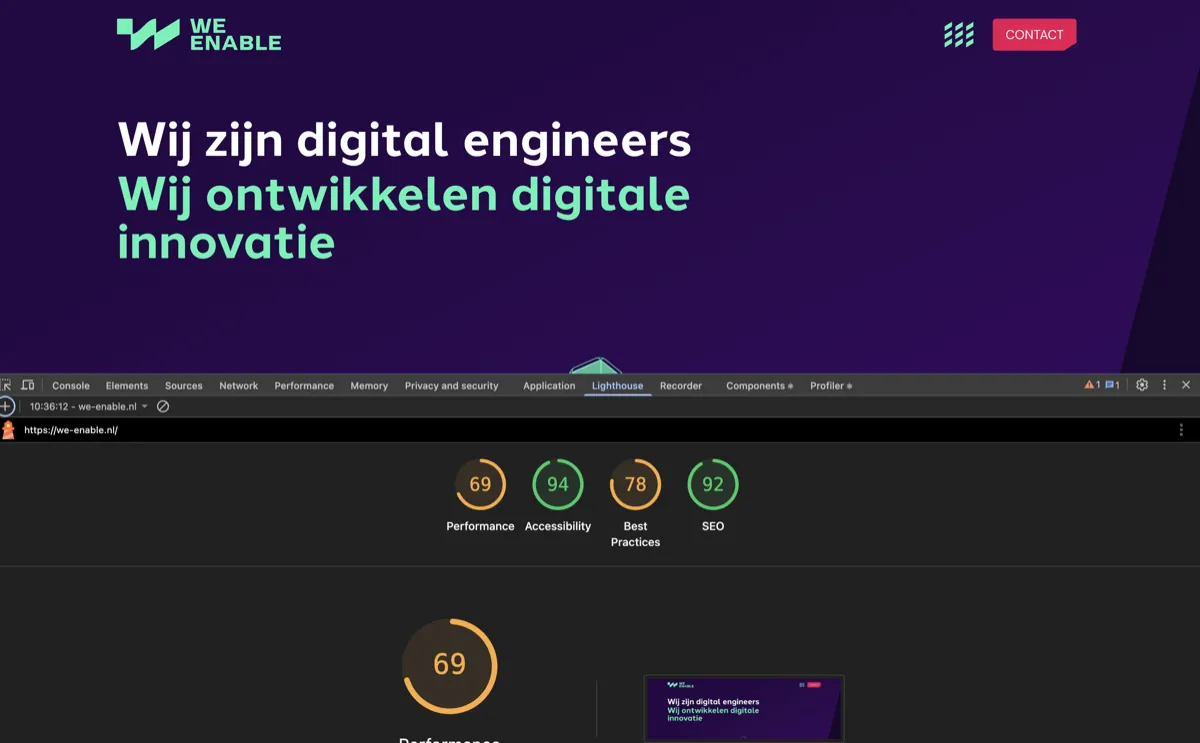
Example 3: Amazon
Amazon needs no introduction—it is the largest e-commerce platform globally.
For educational purposes, we analyzed Amazon’s homepage, which is primarily 2D with minimal animations but contains extensive code and images.
Scenario:
Priority is maximum performance, accessibility, best practices, and SEO.
The goal is to provide users with the fastest, simplest, and most intuitive shopping experience, while implementing effective upselling techniques.
Lighthouse scores:
- Performance: 87/100
- Accessibility: 86/100
- Best Practices: 74/100
- SEO: 100/100
Takeaway:
Large-scale e-commerce platforms must aim for extremely high scores in all categories.
Even if not perfect, these results reflect Amazon’s focus on optimization.
Web Site :
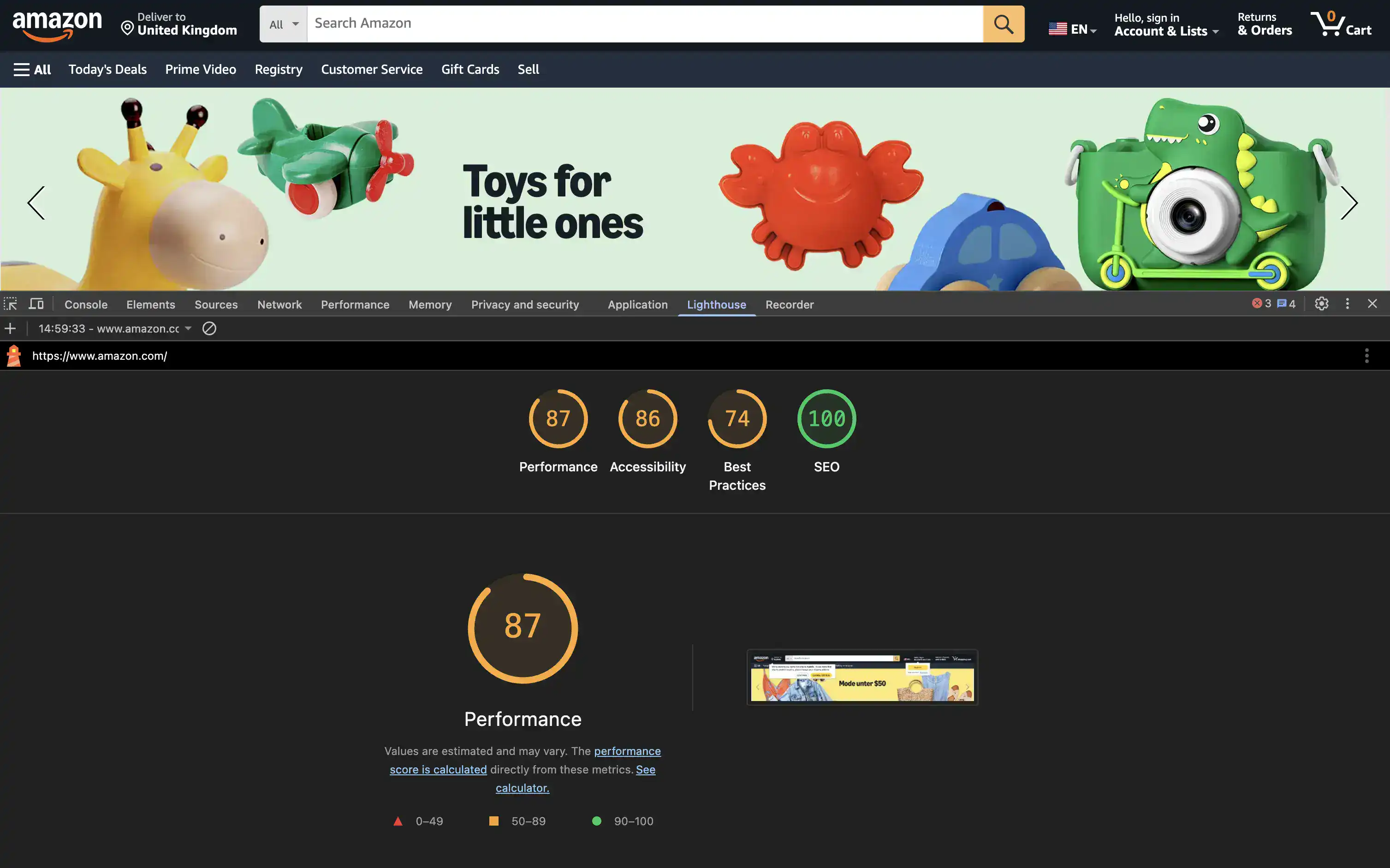
Example 4: manuelcrispino.dev
This is my website, where you are currently reading this article.
It does not use major 2D animations or any 3D animations.
Scenario:
As a developer, I use modern technologies such as React, Next.js, TypeScript, and optimization tools to create fast, modern web experiences.
My top priority is performance, accessibility, best practices, and SEO.
The site is designed to be easy to read, accessible, modern, and elegant, with the main focus on generating leads and ensuring users can read articles without distractions.
Lighthouse scores:
- Performance: 96/100
- Accessibility: 94/100
- Best Practices: 96/100
- SEO: 100/100
Takeaway:
My site is fully optimized for business, portfolio, showcase, and blog purposes.
Future features will maintain high-quality standards.
Web site :
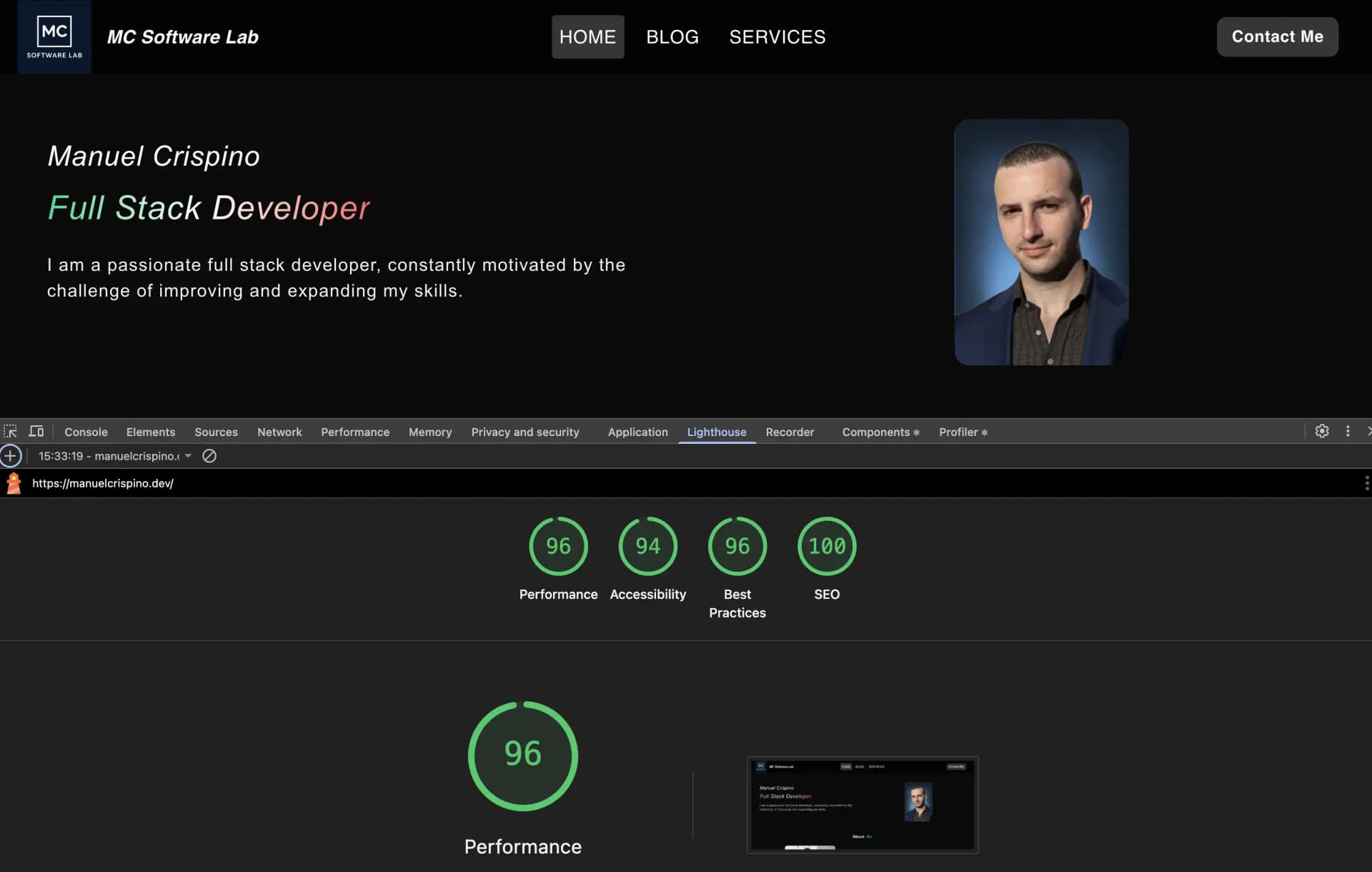
Conclusion
The goal of this article is to help you determine which type of website best suits your needs, highlighting strengths and characteristics of each example.
Whether you are looking for a creative 3D site, a polished business showcase, or a high-performance blog/portfolio, you now have the tools to make an informed decision and understand why each approach works in its context.
Note:
All tests were conducted on September 21-2025, so the results may change in the future.
If you want guidance on building the right website for your business, contact me or check my portfolio.
